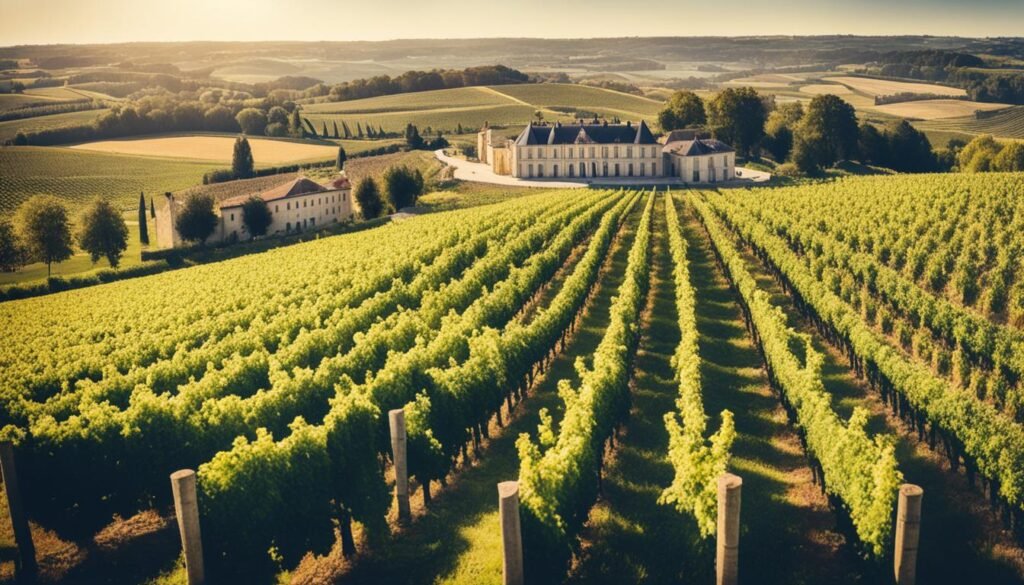Ever pondered the essence of Pétrus wine as a paragon of luxury and prestige within the Bordeaux wine realm? Let’s delve into the rich heritage and captivating allure of this iconic wine. This journey will unveil the intricate details that propel Pétrus to legendary status. Located in the heart of Pomerol, this esteemed vineyard has a fascinating history, dating back to the early 19th century. It attracts wine aficionados and collectors globally.
Our exploration will focus on the unique terroir, meticulous production techniques, and the exquisite taste profile that distinguish Pétrus. Join me as we delve into what makes Pétrus wine a must-have for any luxury wine collection. For an in-depth look at serving tips and wine pairings, check out this comprehensive guide.
Introduction to Pétrus and Its Allure
Pétrus stands at the pinnacle of luxury wine, renowned globally for its scarcity and unparalleled quality. Despite not being officially classified as a First Growth in Bordeaux, its prices often surpass those of such esteemed estates. This wine’s allure attracts connoisseurs and collectors, cementing its status as a fine wine icon.
The petrus estate boasts a storied legacy, with its allure evolving with each vintage. Its terroir, characterized by unique blue clay soils, is pivotal in crafting this extraordinary wine. Predominantly a Merlot focus, Pétrus wines exhibit complex flavors that deliver a profound sensory journey. This distinctive profile not only shapes the wine’s identity but also fuels its allure among those seeking rare and exceptional wines.
Delving into Pétrus reveals its status as an iconic wine, celebrated not solely for its flavor but also for its rich narrative and history. Each bottle tells a tale of tradition and excellence, transcending its role as a beverage to symbolize luxury and ambition.
History of Pétrus Wine and the Estate
The history of Pétrus wine is a tale deeply rooted in Bordeaux’s storied past. Since its inception in 1837, Pétrus has enchanted wine aficionados, thanks to its unique blend. The Arnaud family, initially managing a mere 7 hectares, expanded the estate over time. Their commitment to cultivating exceptional Merlot grapes laid the foundation for Pétrus’s esteemed reputation.
The Origins of Pétrus: A Legacy Since 1837
First documented in 1837, Pétrus’s journey began with a focus on Merlot, which would eventually become 100% of its production by 2010. This shift cemented its status as a paragon of quality wine. The estate’s evolution is a testament to the winemaking art and the unwavering dedication of its predecessors. The 1945 vintage was a turning point, propelling Pétrus into the global spotlight and solidifying its place in Bordeaux wine history.
The Transformation Under Madame Loubat
Madame Loubat’s acquisition of Pétrus in 1940 ushered in a transformative era. Her vision, coupled with Jean-Pierre Moueix’s expertise, broadened the estate’s reach, especially in the United States. Despite the challenges of the 1956 winter, Madame Loubat chose to preserve the estate’s heritage by nurturing its mature vines. This bold decision profoundly influenced the wine’s character, contributing to Pétrus’s status as a luxury wine icon.

| Year | Historical Event | Significance |
|---|---|---|
| 1837 | First mention of Pétrus | Marked the origins of a prestigious vineyard |
| 1940 | Madame Loubat becomes proprietor | Pioneered the wine’s transformation and expansion |
| 1945 | Remarkable vintage | Elevated Pétrus’ status in global wine markets |
| 1956 | Severe winter damage | Strategic decision to retain older vines enhanced wine character |
| 2010 | Transition to 100% Merlot | Reinforced Pétrus’ identity in luxury wines |
The Vineyard’s Unique Terroir and Production Techniques
The Pomerol vineyard, especially Pétrus, is renowned for its distinctive terroir. This terroir is crucial for creating exceptional wines. The region’s blue clay soils are key to growing Merlot vines. These soils, formed over 40 million years ago, create a perfect environment for grape growth, especially in dry conditions.
These soils also influence the roots of the vines, leading to the velvety tannins found in Pétrus wines. This unique terroir and soil composition are vital to the production techniques used at Pétrus, resulting in wines known for their richness and elegance.
Exploring the Blue Clay Soils of Pomerol
The blue clay soils of Pomerol vineyard ensure good drainage while retaining moisture. This balance is ideal for growing high-quality Merlot vines. The grapes develop optimal flavors under these conditions. The deep root systems of the vines add complexity and depth to the grapes.
This terroir at Pétrus is essential for the winemaking process. It leads to wines celebrated for their richness and elegance.
Hand Harvesting and Selection Processes
Hand harvesting is crucial at Pétrus. It ensures careful grape selection, vital for maintaining high standards. The team focuses on the grapes’ health during harvest. They use plastic sheeting for rain protection and helicopters to nourish the vines.
These techniques help minimize damage during handling. This ensures the grapes arrive at the winery in top condition.
This detailed approach to grape selection and harvesting allows Pétrus to produce around 25,000 to 30,000 bottles annually. The rarity, combined with its unique terroir and refined techniques, makes Pétrus a standout choice for wine lovers. For more insights on red wines, check out this list of must-know red wines.
Petrus Wine: A Rare and Sought-After Bordeaux
Pétrus is a symbol of prestige in the wine market, known for its scarcity and unparalleled quality. Its allure is undeniable, especially for collectors looking to invest in wine. Rare bottles like Pétrus command high prices, making them a luxury for connoisseurs and investors alike.
Understanding Its Value in the Wine Market
The rare wine value of Pétrus goes beyond its taste. It’s a blend of exclusivity, historical importance, and consistent praise from wine critics. Legendary vintages often exceed $10,000 at auctions, positioning Pétrus as a key player in the luxury wine market. Vintages like 1945, 2000, and 2015 are prime examples, selling for high prices due to their scarcity.
The Iconic Vintages and Their Significance
Several iconic vintages highlight the importance of Pétrus in Bordeaux wine history. Vintages such as 1929, 1947, and 1982 are celebrated for their unique profiles and aging potential. These vintages showcase the impact of terroir and vineyard practices on the final product. Their recognition solidifies Pétrus’s esteemed status and lasting legacy in the wine world.

The Taste Profile of Pétrus Wine
Pétrus is renowned for its exceptional flavor profile and intricate aromatic complexity. Its taste is a blend of dark fruits, chocolate, and subtle truffle notes. The taste of Pétrus wine is enriched by smooth tannins, offering a lasting sensory delight with every sip.
Flavor Notes and Aromatic Complexity
This wine is a masterpiece of flavors, often noted by experts as cassis, plum, cherry, and violet. Each vintage brings a unique set of aromas that mature over time. The distinctiveness of Pétrus stems from the Pomerol region’s soil, which favors Merlot, resulting in wines of deep character and complexity. For more insights, visit this link.
Aging Potential and Ideal Serving Practices
Pétrus wines have notable wine aging potential, often improving with at least 15 years in the cellar. Exceptional vintages can last over five decades, showcasing profound flavors and aromas. Proper storage in a controlled environment is crucial. Serving Pétrus wine under the right conditions, including careful decanting, enhances the tasting experience by allowing the wine to breathe and its flavors to develop fully.
Conclusion
Pétrus wine stands out as a perfect fusion of deep history, exceptional terroir, and careful craftsmanship. It has earned a revered status in the fine wine world. This Bordeaux red blend has won over wine aficionados and secured a high reputation in the market with its profound depth and complexity. Reflecting on my experience with Pétrus, it’s clear that each sip embodies the vineyard’s unique qualities and the expertise of its creators.
The significance of the Bordeaux red blend is clear as I explore the stories behind each vintage. Each bottle narrates the detailed care in the growing and harvesting process, safeguarding the fruit’s purity and the elegance that defines Pétrus. This wine’s allure will continue to enchant collectors and enthusiasts, keeping its position as a symbol of unmatched luxury.
In conclusion, Pétrus wine is more than just its flavors or aromas; it’s the entire experience in every glass. My respect for this exquisite wine remains strong, and I believe its outstanding qualities will ensure its continued acclaim in the wine community. For those interested in the complexity of Pétrus wines and other remarkable ones, exploring Pétrus’ official profile is recommended. Additionally, discovering the bold flavors of other varietals like Petit Verdot, essential for enriching your wine collection, can be found at this informative source.